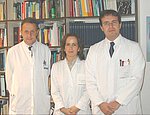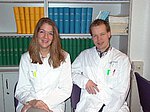Checking patients with simple an complicated HSP by DTI to find subtyping of the heterogeneous group of disease


Cerebral, corticospinal and corticocortical variances at patients with simple and complicated FSP at the Diffusion-Tensor-imaging(DTI)
Applicant: Dr. med. M. Sach Neurologische Klinik und Poliklinik Hamburg-Eppendorf Martinistrasse 52 20246 Hamburg
Email: sach@uke.uni-hamburg.de
together with:
Voxel-basierte 3D-MRT-Morphometrie und molekulargenetische Untersuchungen bei komplizierter FSP mit dünnem Corpus callosum
Appilcant: Dr. med. Jan Kassubek Neurologische Klinik und Poliklinik der Universität Ulm Oberer Eselsberg 45 89081 Ulm
Email: jan.kassubek@medizin.uni-ulm.de
Summary
Elaborated clinical phenotype and genotype analyses serve as the basis to improve our understanding of the pathogenic mechanisms causing certain subtypes of hereditary spastic paralysis (HSP). Magnetic resonance imaging (MRI) and electrophysiological investigations are useful tools for this aim. In this study, modern MRI acquisition and analysis techniques of the brain are applied in patients suffering from HSP. First, changes in the cerebral fibertracks (beyond the pyramidal system) will be investigated using Diffusion Tensor Imaging (DTI) (University Hospital Hamburg). Second, regional volume changes in the brain will be studied by use of the technique of Voxel-based Morphometry (VBM) (University Hospital Ulm), especially with respect to abnormalities besides the well-known corpus callosum hypoplasia in complicated HSP forms. In addition, electrophysiological techniques (motor evoked potentials) will be performed. Moreover, the established gene loci and, if negative, other candidate genes will be investigated.
final reports
Hamburg PDF- File (sorry only German)
ULM:
Clinically, patients with hereditary spastic paraplegia (HSP) are classified into pure (pHSP) and complicated (cHSP) forms. The common hallmark of both and the main characteristic in pHSP is a progressive spastic paraplegia. In cHSP patients additional symptoms out of a broad spectrum occur (dementia, epilepsy, cataract, skin abnormalities, etc.). From the molecular genetic point of view, 28 loci and 10 genes have been discovered to date. Interestingly, some mutations can be associated with cHSP as well as with pHSP forms. Until now, brain imaging studies in HSP were mostly casuistic, and in some cHSP cases a thin corpus callosum (CC) was reported.
We report an investigation of 33 consecutive HSP patients recruited from the HSP outpatient clinic of the Department of Neurology, University of Ulm. We evaluated 21 patients (from 18 families; 10 female/11 male, aged 49 ± 10 years) suffering from pHSP and 12 patients (from 9 families; 4/8, 29 ± 11 years) suffering from cHSP. Fourteen pHSP patients had an autosomal dominant (AD) inheritance pattern (7 males/7 females; 6 patients carrying a spastin mutation), and seven had a sporadic (S) HSP (4/3). In the cHSP group, there were three male patients each with AD HSP and S HSP and in addition six patients (2/4) who could not be differentiated into autosomal recessive or X-linked HSP forms. In all patients, a standardized neuropsychological testing was done besides extensive clinical and electrophysiological investigations: neuropsychological evaluation was focused on the presence of dementia and the domains working and episodic memory, alertness and executive functions in comparison to an age- and education-matched control group. Besides abnormalities in a subtest of the working memory, all other domains were in the normal range in pHSP. In contrast, the cHSP patients showed markedly abnormal results in all neuropsychological domains as compared to their controls (p<0.05).
High-resolution whole head 3-D MRI data of all patients were collected on the same 1.5 Tesla clinical scanner (Siemens Symphony©, Erlangen, Germany) using the same scanning protocol. The imaging protocol included additional T1- and T2-weighted sequences of the brain and the upper cervical and thoracal spinal cord. First, a visual analysis of all MRI was done. Second, a computer-based evaluation using the optimized voxel-based morphometry as a whole brain based technique was performed to detect regional volume changes. VBM analysis was done for cHSP and pHSP patients separately as compared to an individual age-matched control sample each. Additionally, all CC were measured by region-of-interest (ROI) based volumetry. Then, the brain parenchymal fractions (BPF) were calculated from the 3-D MRI data according to an automated protocol to investigate possible global brain atrophy. Then, planimetric measurements of the spinal cord were performed by use of standardized procedures on digital data.
Visual analysis of MRI from the pHSP patients was normal. In contrast, some cHSP patients showed diffuse white matter lesions and in 6 cases an obvious CC thinning. In pHSP, VBM analysis revealed few small voxel clusters of decreased cortical volumes in the gray matter analysis and a circumscribed region within the CC splenium in the white matter analysis. In opposite, large areas of decreased grey matter in parietal regions and a marked large-scale volume reduction including the whole CC in white matter were found in cHSP. Region-based analysis showed normal CC volumes in pHSP and highly significantly reduced volumes in cHSP patients. Furthermore, the whole brain volume (BPF) was significantly reduced in cHSP whereas in pHSP, BPF was only slightly reduced as compared to the individual control cohort. Significant atrophy was observed in both the cervical and the thoracal spinal cord measurements in both HSP patient groups, but there were no differences between the patient groups.
In summary, in the largest HSP collective investigated so far, the various imaging modalities showed abnormalities in cerebral and spinal regions. This finding might expand the patho-anatomical understanding for the different disease groups. If it is useful to include the imaging modalities into the individual diagnostic work-up of HSP has to await further studies.
Aspects of the study were published in scientific journals:
o Global brain atrophy in pHSP and cHSP patients (accepted in European Journal of Neurology, in press) ® pdf kassubek_EurJNeurol_inpress
o Spinal cord atrophy in pHSP and cHSP (accepted in European Neurology, in press)
® pdf sperfeld_EurNeurol_inpress
o Clinical, electrophysiological, neuropsychological, and regional differences in brain morphology in pHSP and cHSP patients (in preparation)
o Dissertation of Mrs. Annette Baumgartner (in preparation)
Excerpts of the results were presented as lecture or poster presentation on following meetings: Kongress der Deutschen Gesellschaft für Klinische Neurophysiologie 2004 (TWS-Symposium), Kongress der Deutschen Gesellschaft für Neurologie 2005, Kongress der Deutschen Gesellschaft für Muskelkranke 2005, Annual Meeting of the Organization for Human Brain Mapping 2005





